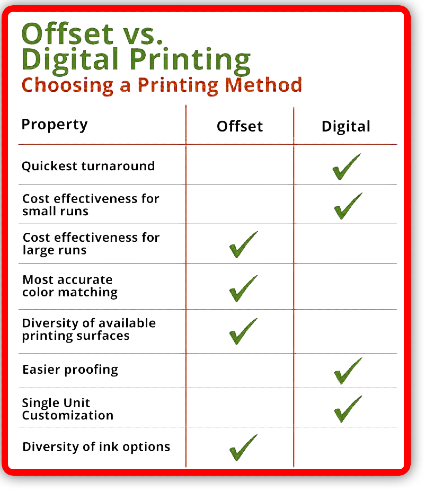The Single Strategy To Use For Digital Printing
Table of Contents4 Easy Facts About Digital Printing DescribedThe Only Guide for Digital PrintingDigital Printing for BeginnersDigital Printing Things To Know Before You BuyDigital Printing Fundamentals ExplainedWhat Does Digital Printing Mean?
Variable data printing, such as straight mail with customized codes and addresses, is ideally suited for digital printing. Digital quick printing just requires four actions of layout, review, printing and binding to obtain everything done. Digital quick printing has an unparalleled benefit: print on need.According to PMMI, electronic printing permits brands and producers to react promptly to consumer needs while boosting the supply chain, reducing warehousing cost and waste, and enjoying faster time to market. That all noises fantastic, however just how does this technology do all that? The significant differentiator of these modern technologies is that there are no set-up costs and no plates with electronic printing.
The Greatest Guide To Digital Printing
According to Wikipedia, the greatest distinction in between digital printing and traditional techniques such as lithography, flexography, gravure, or letterpress - Digital Printing is that there is no need to change printing plates in digital printing, whereas in these analog printing methods home plates are repeatedly changed. This leads to quicker turnaround time and decreases cost when making use of electronic printing.
Digital printing is extremely versatile, so it's very easy to make modifications to the bundle layout quickly. It all goes back to the plates.
With conventional printing techniques, short-run printing is simply not feasible. Since an excellent layout can make or break your product, digital printing regularly produces high-grade, clear and vibrant graphics each time.
Digital printing is the process of printing digital-based photos straight onto a range of media substratums. There is no need for a printing plate, unlike with offset printing. Digital data such as PDFs or desktop computer posting files can be sent directly to the digital printing press to publish theoretically, image paper, canvas, textile, synthetics, cardstock and other substrates.
What Does Digital Printing Mean?
According to PMMI, electronic printing allows brand names and makers to react promptly to consumer needs while improving the supply chain, decreasing warehousing expense and waste, and delighting in faster time to market. That all audios fantastic, but exactly how does this technology do all that? The significant this website differentiator of these technologies is that there are no set up fees and no plates with electronic printing.
According to Wikipedia, the biggest difference between digital printing and typical approaches such as lithography, flexography, gravure, or letterpress is that there is no need to replace printing plates in digital printing, whereas in these analog printing approaches home plates are repeatedly changed. This leads to quicker turnaround time and lowers expense when utilizing electronic printing.

All About Digital Printing
Much more supply can indicate more waste down the road. With conventional printing techniques, short-run printing is simply not possible. Since a great style can make or damage your item, electronic printing constantly develops top notch, clear and vibrant graphics each time. Digital printing on adaptable bags adds the intense, lively, and precise graphics that almost bid consumers to connect and touch them.

According to PMMI, digital printing allows brands and makers to react quickly to client needs while improving the supply chain, reducing warehousing expense and waste, and enjoying faster time to market. That all audios excellent, but how does this technology do all that? The significant differentiator of these modern technologies is that there are no set up costs and no plates with digital printing.
Some Known Incorrect Statements About Digital Printing
According to Wikipedia, the biggest difference in between digital printing and traditional techniques such as lithography, flexography, gravure, or letterpress is that there is no need to change printing plates in digital printing, whereas in these analog printing approaches the plates are repetitively changed. This leads to quicker turnaround time and decreases expense when using electronic printing.
Digital printing is highly versatile, so it's very easy to make modifications to the package style promptly. It all goes back to the plates.

The Main Principles Of Digital Printing
Digital printing is the procedure of printing digital-based pictures directly onto a variety of media substratums. There is no requirement for a printing plate, unlike with offset printing. Digital data such as PDFs or desktop computer posting files can be sent straight to the electronic printing machine to publish theoretically, image paper, canvas, textile, synthetics, cardstock and other substrates.